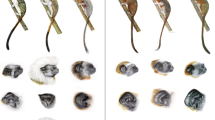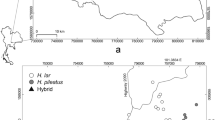Abstract
Hybridization between Alouatta spp. has been suggested at contact zones of A. palliata and A. pigra in Mexico and of A. caraya and A. guariba clamitans in Brazil and Argentina. Whereas genetic data confirmed hybridization between the former pair of species, hybrid individuals of the latter pair have been putatively identified on the basis of a mosaic pelage color. In this paper, we describe the first confirmed cases of hybridization between a female A. guariba clamitans and a male A. caraya. One hybrid male was born in 2007 and one hybrid female was born in 2009 with distinct coat colors. The male resembled the newborn color pattern characteristic of A. guariba clamitans, whereas the female resembled the newborn pattern of A. caraya. The birth and survival of the male hybrid for a year and a half indicated the viability of the heterogametic sex.
Similar content being viewed by others
Avoid common mistakes on your manuscript.
Introduction
Natural hybridization is a phenomenon observed in all major primate lineages—strepsirrhines, New World monkeys, Old World monkeys, and apes (Arnold and Meyer 2006). Among New World monkeys, there are reports of wild hybrids in the genera Saimiri (Silva et al. 1992), Callithrix (Alonso et al. 1987; Coimbra-Filho et al. 1993; Mendes 1997), Saguinus (Peres et al. 1996), and Alouatta (Gregorin 2006; Aguiar et al. 2007, 2008; Cortés-Ortiz et al. 2007; Agostini et al. 2008; Bicca-Marques et al. 2008; Cortés-Ortiz 2009).
In Alouatta, hybridization between A. palliata (mantled howler monkeys) and A. pigra (black howler monkeys) in Mexico was confirmed by genetic data (Cortés-Ortiz et al. 2007; Cortés-Ortiz 2009). Observation of adult males with coats showing a mosaic of black and red and of adult females with an admixture of yellowish and dark brown at contact zones between A. caraya (black-and-gold howler monkeys) and A. guariba clamitans (brown howler monkeys) in Brazil suggests that these taxa can also hybridize in the wild (Gregorin 2006; Aguiar et al. 2007, 2008; Bicca-Marques et al. 2008). A. caraya and A. guariba clamitans are the only two sexually dichromatic taxa in the genus (Bicca-Marques and Calegaro-Marques 1998). In the former species, adult males are fully black and adult females are yellowish, whereas adult males are deep reddish and adult females are dark brown in the latter (Gregorin 2006). In both species, males and females are born with similar coats that resemble the maternal pattern. In addition, Agostini et al. (2008) report an adult female A. caraya living within an A. guariba clamitans group in Argentina, copulating with the males, and giving birth to two infants with hybrid morphotypes in two consecutive years. Although these observations are strongly suggestive of natural hybridization, the fact that extragroup copulations have been observed in several howler monkey species (Horwich 1983; Agoramoorthy and Hsu 2000; Kowalewski et al. 2005; Fialho and Setz 2007) does not allow ruling out the hypothesis that the adult female A. caraya of this mixed-species group copulated with conspecific males during intergroup encounters at this contact zone.
Here we report the first cases of hybridization between A. guariba clamitans and A. caraya where the maternal and paternal species are known, and we describe the distinct pelage patterns shown by the two hybrid newborns.
Methods
A mixed group composed of an adult female A. guariba clamitans and an adult female and an adult male A. caraya was kept in an enclosure 4 × 5 × 5 m enriched with branches, poles, and a wood shelter at “Criadouro Conservacionista Arca de Noé” in Morro Reuter, State of Rio Grande do Sul, Brazil from April 2005. The three individuals were confiscated from the illegal trade by the Brazilian Environmental Authority (IBAMA). Although their origin is unknown, their pelage color allows us to strongly suggest they are pure individuals: the adult female A. guariba clamitans is dark brown; the adult female A. caraya is yellowish, and the adult male is fully black. The female A. guariba clamitans arrived as a dependent, unweaned infant and was hand-reared by the owners of the facility. As she grew older, she was kept in an enclosure at the side of the enclosure where the adult couple and another adult male A. caraya were kept. These individuals adopted her, and she was moved into their enclosure with the intention of improving their welfare. Soon after, all individuals were moved to the larger enclosure mentioned above. Later, the adult males began to fight, and one was removed from the enclosure. Because of tooth surgery, the adult male who sired the hybrid offspring was kept at another enclosure between late December 2008 and early March 2009. Upon his return, the adult female A. guariba clamitans and her infant were moved to an exclusive enclosure in an, unsuccessful, attempt to avoid further hybridization events.
Results
In September 2007, the adult female A. guariba clamitans gave birth to a hybrid infant male with a color pattern resembling the dark brown pelage of newborns of her species. When this individual died at the age of 1 year and 6 months, his pelage color was a mosaic of brown (characteristic of female and immature male A. guariba clamitans) and black (characteristic of adult and maturing A. caraya males) (Fig. 1).
A hybrid infant female was born in April 2009 with a predominance of the light, beige coloration characteristic of her paternal species (Fig. 2a, b). At about 3 months of age, her color pattern had changed to a mosaic between beige (characteristic of youngster A. caraya) and brown (characteristic of youngster A. guariba clamitans; Fig. 2c), whereas from the age of 5–9 months, her mosaic coloration most resembled her maternal species (Fig. 2d–f).
Hybrid female born in 2009 showing the gradual color change: a soon after birth (April), showing her beige coat (characteristic of Alouatta caraya newborns), with her brown A. guariba clamitans mother; and at the age of b 1 month (May), c 3 months (July, riding on her mother’s back), d 5 months (September), e 7 months (November), and f 9 months (January 2010)
Discussion
These observations confirm the viability of infant hybrids between A. caraya and A. guariba clamitans, taxa belonging to clades separated for 5.1 Ma (Cortés-Ortiz et al. 2003), supporting the observations of Agostini et al. (2008) in Argentina; and the relationship between this phenomenon and the mosaic coloration of hybrid offspring, as suggested by Gregorin (2006), Aguiar et al. (2007, 2008), and Bicca-Marques et al. (2008). Additionally, the two hybrids reported in this study were born with distinct pelage color patterns despite the fact they are offspring of the same parents. Although the parents are very likely pure individuals, in the absence of genetic data and information on their origin, we cannot eliminate the possibility that one or both of them are also hybrids. In this case, their offspring would represent backcrosses or multigenerational hybrids.
Unlike the crosses between A. palliata and A. pigra that produce inviable or infertile male offspring (Cortés-Ortiz et al. 2007; Cortés-Ortiz 2009), crosses between A. caraya and A. guariba clamitans can produce viable males. Additionally, the data from Argentina (Agostini et al. 2008) and from this study reveal that male offspring of this latter pair of taxa is viable regardless of the species to which each parent belongs. Whereas we report breeding of a female A. guariba clamitans with a male A. caraya, the opposite is reported by Agostini et al. (2008). The fertility of these hybrid males could not be assessed because all three died before reaching adulthood.
Genetic studies are imperative to confirm the status conferred to individuals at contact zones as pure or hybrid on the basis of coat color only to assess the fertility and reproductive success of both male and female hybrids and occurrence of backcrosses, and to understand the genetic basis of newborn and adult color determination in these sexually dichromatic howler monkey species.
References
Agoramoorthy G, Hsu MJ (2000) Extragroup copulation among wild red howler monkeys in Venezuela. Folia Primatol 71:147–151
Agostini I, Holzman I, Di Bitetti MS (2008) Infant hybrids in a newly formed mixed-species group of howler monkeys (Alouatta guariba clamitans and Alouatta caraya) in northeastern Argentina. Primates 49:304–307
Aguiar LM, Mellek DM, Abreu KC, Boscarato TG, Bernardi IP, Miranda JMD, Passos FC (2007) Sympatry between Alouatta caraya and Alouatta clamitans and the rediscovery of free-ranging potential hybrids in Southern Brazil. Primates 48:245–248
Aguiar LM, Pie MR, Passos FC (2008) Wild mixed groups of howler species (Alouatta caraya and Alouatta clamitans) and new evidence for their hybridization. Primates 49:149–152
Alonso C, Faria DS, Langguth A, Santee DF (1987) Variação da pelagem na área de intergradação entre Callithrix jacchus e Callithrix penicillata. Rev Brasil Biol 47:465–470
Arnold ML, Meyer A (2006) Natural hybridization in primates: one evolutionary mechanism. Zoology 109:261–276
Bicca-Marques JC, Calegaro-Marques C (1998) Behavioral thermoregulation in a sexually and developmentally dichromatic neotropical primate, the black-and-gold howling monkey (Alouatta caraya). Am J Phys Anthropol 106:533–546
Bicca-Marques JC, Prates HM, Aguiar FRC, Jones CB (2008) Survey of Alouatta caraya, the black-and-gold howler monkey, and Alouatta guariba clamitans, the brown howler monkey, in a contact zone, State of Rio Grande do Sul, Brazil: evidence for hybridization. Primates 49:246–252
Coimbra-Filho AF, Pissinatti A, Rylands AB (1993) Experimental multiple hybridism and natural hybrids among Callithrix species from eastern Brazil. In: Rylands AB (ed) Marmosets and tamarins: systematics behaviour and ecology. Oxford University Press, Oxford, pp 95–120
Cortés-Ortiz L (2009) Genetic and morphological characterization of hybridization of howler monkeys in Mexico. Primate Rep (Spec Issue) 1:12
Cortés-Ortiz L, Bermingham E, Rico C, Rodríguez-Luna E, Sampaio I, Ruiz-García M (2003) Molecular systematics and biogeography of the Neotropical monkey genus, Alouatta. Mol Phylogenet Evol 26:64–81
Cortés-Ortiz L, Duda TF Jr, Canales-Espinosa D, García-Orduña F, Rodríguez-Luna E, Bermingham E (2007) Hybridization in large-bodied New World primates. Genetics 176:2421–2425
Fialho MS, Setz EZF (2007) Extragroup copulations among brown howler monkeys in southern Brazil. Neotrop Primates 14:28–30
Gregorin R (2006) Taxonomia e variação geográfica das espécies do gênero Alouatta Lacépède (Primates, Atelidae) no Brasil. Rev Brasil Zool 23:64–144
Horwich RH (1983) Breeding behaviors in the black howler monkey (Alouatta pigra) of Belize. Primates 24:222–230
Kowalewski MM, Peker SM, Zunino GE (2005) Promiscuous howlers: extra-group copulation in female Alouatta caraya in northern Argentina. In: Bicca-Marques JC (ed) Programa e livro de resumos do XI Congresso Brasileiro de Primatologia. Sociedade Brasileira de Primatologia, Porto Alegre, p 116
Mendes SL (1997) Hybridization in free-ranging Callithrix flaviceps and the taxonomy of the Atlantic Forest marmosets. Neotrop Primates 5:6–8
Peres CA, Patton JL, Silva MNF (1996) Riverine barriers and gene flow in Amazonian saddle-back tamarins. Folia Primatol 67:113–124
Silva BTF, Sampaio MIC, Schneider H, Schneider MPC, Montoya E, Encarnación F, Salzano FM (1992) Natural hybridization between Saimiri taxa in the Peruvian Amazonia. Primates 33:107–113
Acknowledgments
We thank Liliana Cortés-Ortiz and an anonymous reviewer for constructive comments on an earlier version of this manuscript. JCBM also thanks the Brazilian National Research Council for a research fellowship (CNPq #306090/2006-6 and 303154/2009-8).
Author information
Authors and Affiliations
Corresponding author
About this article
Cite this article
de Souza Jesus, A., Schunemann, H.E., Müller, J. et al. Hybridization between Alouatta caraya and Alouatta guariba clamitans in captivity. Primates 51, 227–230 (2010). https://doi.org/10.1007/s10329-010-0192-8
Received:
Accepted:
Published:
Issue Date:
DOI: https://doi.org/10.1007/s10329-010-0192-8






